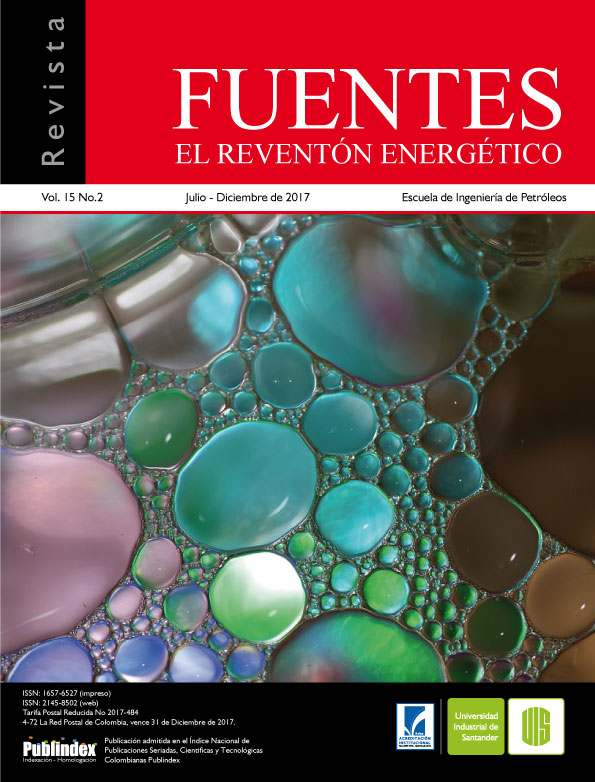Analytical feasibility of the application of improved petroleum recovery, case study Ecuador
Published 2017-12-15
Keywords
- EOR,
- Emprove Oil Recovery,
- Composition of oil,
- Push Mechanisms
How to Cite
Abstract
Improving the recovery factor is sufficient motivation for any company to include in its planning, a feasibility study to set up the improved recovery technology, also known as EOR, for its acronym. This method consists in injecting miscible fluid, to favorably alter the rock-fluid conditions and to move the hydrocarbon to the producing wells, giving rise to a complex dynamics in the reservoir. From the information obtained in the field, such as: PVT data, production history, recovery factor, correlations, well geometry and together with the selection criteria demanded by this technology, we can proceed to design an injection model miscible, deepen the simulation of the site and obtain predictions not so far removed from reality.
EOR is one of the technologies that takes advantage of the unproductive wells in good condition and can be injected into the reservoir more than 16 fluids to provide a sweeping effect that optimizes production, however apply one of these selected EOR methods, can be expensive in the industry, for this reason the present study allows to determine the best option to implement one of these techniques and to guarantee an effective return of investment and an adequate use of capital, which presents a challenge to engineering.
Downloads
References
2. Alvarado, V. & Manrique, E. (2010). Field Planning and Development Strategies. Elsevier, Burlington, USA. (190).
3. Alvarado, V., Ranson, A., Hernández, K., Manrique, E., Matheus, J., Liscano, T. & Prosperi, N. (2012). Selection of EOR/ IOR Opportunities Based on Machine Learning; Society of Petroleum Engineers. 78332. (11).
4. Bazin, B., Douarche, F., Tabary, R., Pedraza, S., Moreau, P. & Morvan M. (2011). An Advanced Methodology for Surfactant Based Pilott Design; Society of Petroleum Engineers, 144312 (8).
5. Buckley, S. (1955). Correlation of Ultimate Oil Recovery with Reservoir Characteristics. World Petroleum Congress, Houston; 6121 (12).
6. Jía, X., Zeng, F. & Gu, J.(2013); Pressure Pulsing Cycling Solvent Injection (PP: CSI): A new way to enhance the recovery of heavy oil through solvent- based enhanced oil recovery techniques; Society of Petroleum Engineers, 154236 (10).
7. Li, Z., Song, X., Wang, Q., Zhang, L., Guo, P. & Li, Xiangliang. (2009). Enhance Foam Flooding Pilot Test in Chengdong Of Shengli Oilfield: Laboratory Experiment And Field Performance. International Petroleum Technology Conference. 13575 (14).
8. Lake, L. & Walsh, M. (2008). Enhanced Oil Recovery (EOR) Field Data Literature Search. Texas; University of Texas at Austin, (116).
9. Mogollón, José L (2013). A new approach to accelerate and optimize EOR deployment; World Petroleum Congress, Manta- Ecuador (10).
10. Moore, R., Mehta, S., Ursenbach, M. & Gutierrez, D. (2012). Potential for In Situ Combustion in Depleted Conventional Oil Reservoirs. Society of Petroleum Engineers.154299 (14).
11. Pandey, A., Kumar, M., Jha, M., Tandon, R., Punnapully, B., Kalugin, M., Khare, A. & Beliveau, D. (2012). Chemical EOR Pilot in Mangala Field: Results of Initial Polymer Flood Phase; Society of Petroleum Engineers. 154159 (10).
12. Salager, J., Forgiarini, A., Márquez, L., Bullón, J. (2013). How to Attain an Ultralow Interfacial Tension and a Three-Phase Behavior with a Surfactant Formulation for
Enhanced Oil Recovery. Springer Berlin Heidelberg. 1097- 3958 (32).
13. Shojaei, H., Rastegar, R. & Jessen, K.(2012). Experimental and Modeling Study of Multicontact Miscible Displacements; Society of Petroleum Engineers. 154307 (19).
14. Schubarth, S., Bazan, L., Becnel, J., Wagner, A. & Manrique, J. (2002). Increasing Well Productivity in the Wilcox Lobo Trend. Society of Petroleum Engineers. 75677 (10).
15. Spildo K., Johannessen A. & Skauge A. (2012). Low Salinity Waterflood at Reduced Capilarity; Society of Petroleum Engineers, 154236 (10).
